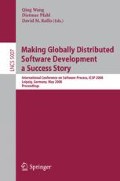Abstract
Software process analysis and improvement relies heavily on empirical research. Empirical research requires measurement, experimentation, and modeling. Moreover, whatever evidence is gained via empirical research is strongly context dependent. Thus, it is hard to combine results and capitalize upon them in order to improve software development processes in evolving development environments. The process simulation model GENSIM 2.0 addresses these challenges. Compared to existing process simulation models in the literature, the novelty of GENSIM 2.0 is twofold: (1) The model structure is customizable to organization-specific processes. This is achieved by using a limited set of macro-patterns. (2) Model parameters can be easily calibrated to available empirical data and expert knowledge. This is achieved by making the internal model structures explicit and by providing guidance on how to calibrate model parameters. This paper outlines the structure of GENSIM 2.0, shows examples of how to calibrate the simulator to available empirical data, and demonstrates its usefulness through two application scenarios. In those scenarios, GENSIM 2.0 is used to rank feasible combinations of verification and validation (V&V) techniques with regards to their impact on project duration, product quality and resource consumption. Though results confirm the expectation that doing more V&V earlier is generally beneficial to all project performance dimensions, the exact rankings are sensitive to project context.
Access this chapter
Tax calculation will be finalised at checkout
Purchases are for personal use only
Preview
Unable to display preview. Download preview PDF.
References
Abdel-Hamid, T.K., Madnick, S.E.: Software Projects Dynamics – an Integrated Approach. Prentice-Hall, Englewood Cliffs (1991)
Angkasaputra, N., Pfahl, D.: Making Software Process Simulation Modeling Agile and Pattern-based. In: ProSim 2004, pp. 222–227 (2004)
Armbrust, O., et al.: Simulation-Based Software Process Modeling and Evaluation. In: Chang, S.K. (ed.) Handbook of Software Engineering & Knowledge Engineering, Advanced Topics, vol. 3, pp. 333–364. World Scientific, Singapore (2005)
Bandinelli, S., Fuggetta, A., Lavazza, L., Loi, M., Picco, G.P.: Modeling and Improving an Industrial Software Process. IEEE Trans. on Soft. Eng. 21(5), 440–453 (1995)
Damm, L., Lundberg, L., Wohlin, C.: Faults-slip-through - a concept for measuring the efficiency of the test process. Software Process: Improv. and Practice 11(1), 47–59 (2006)
Extend Product Information (March 22, 2007), http://www.imaginethatinc.com/
Forrester, J.W.: Industrial Dynamics. Productivity Press, Cambridge (1961)
Frost, A., Campo, M.: Advancing Defect Containment to Quantitative Defect Management. CrossTalk – The Journal of Defense Software Engineering 12(20), 24–28 (2007)
Gruhn, V., Saalmann, A.: Software Process Validation Based on FUNSOFT Nets. In: Proceedings of EWSPT 1992, pp. 223–226 (1992)
Kellner, M.I., Hansen, G.A.: Software Process Modeling: A Case Study. In: Proceedings of AHICSS 1989, vol. II - Software Track, pp. 175–188 (1989)
Khosrovian, K., Pfahl, D., Garousi, V.: A Customizable System Dynamics Simulation Model of Generic Software Development Processes. Technical Report SERG-2007-07, Schulich School of Engineering, University of Calgary (2007)
Khosrovian, K., Pfahl, D., Garousi, V.: Calibrating a Customizable System Dynamics Simulation Model of Generic Software Development Processes. Technical Report SERG-2007-08, Schulich School of Engineering, University of Calgary (2007)
Khosrovian, K., Pfahl, D., Garousi, V.: Application Scenarios of a Customizable System Dynamics Simulation Model of Generic Software Development Processes. Technical Report SERG-2007-09, Schulich School of Engineering, University of Calgary (2007)
Madachy, R.: Reusable Model Structures and Behaviors for Software Processes. In: Wang, Q., Pfahl, D., Raffo, D.M., Wernick, P. (eds.) SPW 2006 and ProSim 2006. LNCS, vol. 3966, pp. 222–233. Springer, Heidelberg (2006)
Mi, P., Scacchi, W.: A knowledge-based environment for modeling and simulating software engineering processes. IEEE Trans. on Know. and Data Eng. 2(3), 283–294 (1990)
Müller, M., Pfahl, D.: Simulation Methods. In: Singer, J., Shull, F., Sjøberg, D. (eds.) dvanced Topics in Empirical Software Engineering: A Handbook, pp. 117–153. Springer, London (2007)
Pfahl, D., Lebsanft, K.: Knowledge Acquisition and Process Guidance for Building System Dynamics Simulation Models: An Experience Report from Software Industry. Int. J. of Software Eng. and Knowledge Eng. 10(4), 487–510 (2000)
Pfahl, D., Klemm, M., Ruhe, G.: A CBT module with integrated simulation component for software project management education and training. Journal of Systems and Software 59(3), 283–298 (2001)
Raffo, D.M., Nayak, U., Setamanit, S., Sullivan, P., Wakeland, W.: Using Software Process Simulation to Assess the Impact of IV&V Activities. In: Proceedings of ProSim 2004, Fraunhofer IRB, pp. 197–205 (2004)
Raffo, D., Spehar, G., Nayak, U.: Generalized Simulation Models: What, Why and How? In: Proceedings of ProSim 2003, Portland State University, no page (2003)
Senge, P.: The Fifth Discipline. Doubleday, New York (1990)
Vensim User Manual (March 22, 2007), http://www.vensim.com/
Wagner, S.: A Literature Survey of the Quality Economics of Defect-Detection Techniques. In: Proceedings of ISESE 2006, pp. 194–203 (2006)
Wise, A.: Little-JIL 1.5 Language Report, UM-CS-2006-51. Department of Computer Science, University of Massachusetts, Amherst, MA 01003 (2006)
Author information
Authors and Affiliations
Editor information
Rights and permissions
Copyright information
© 2008 Springer-Verlag Berlin Heidelberg
About this paper
Cite this paper
Khosrovian, K., Pfahl, D., Garousi, V. (2008). GENSIM 2.0: A Customizable Process Simulation Model for Software Process Evaluation. In: Wang, Q., Pfahl, D., Raffo, D.M. (eds) Making Globally Distributed Software Development a Success Story. ICSP 2008. Lecture Notes in Computer Science, vol 5007. Springer, Berlin, Heidelberg. https://doi.org/10.1007/978-3-540-79588-9_26
Download citation
DOI: https://doi.org/10.1007/978-3-540-79588-9_26
Publisher Name: Springer, Berlin, Heidelberg
Print ISBN: 978-3-540-79587-2
Online ISBN: 978-3-540-79588-9
eBook Packages: Computer ScienceComputer Science (R0)

